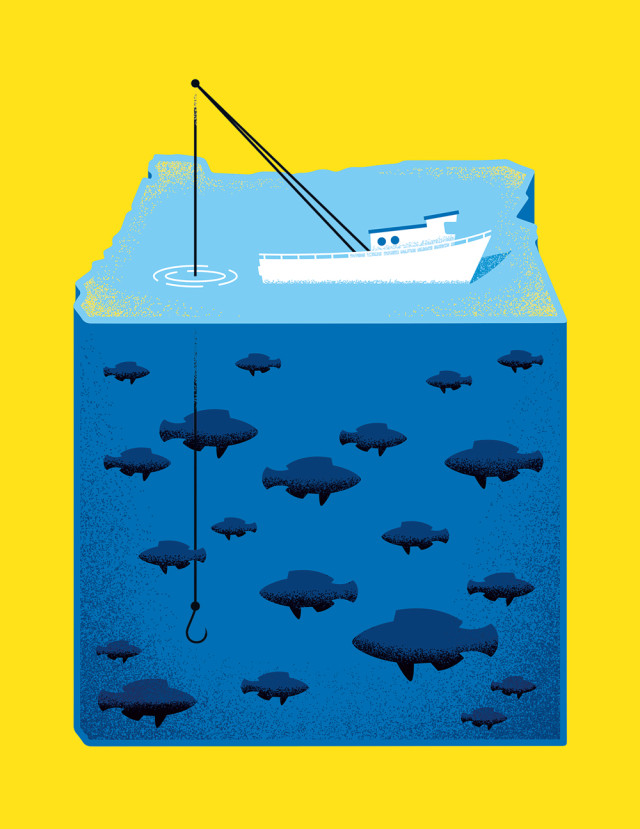Can Portland Chefs Save the Northwest's At-Risk Seafood Stocks?

Image: Matt Chase
My husband and I recently had dinner at Northwest Portland’s Bamboo Sushi, the world’s first certified-sustainable independent seafood restaurant. The server handed us menus based exclusively on fish sourced through groups like the Marine Stewardship Council (MSC), Monterey Bay Aquarium, and Blue Ocean Institute. I agonized over this menu for 45 minutes. Soon enough, my husband was doing the bored finger-drum on his phone while the saintly waitress hovered nearby to field questions. But my problem was, I already knew too much.
For the past five years, I’ve reported on the seafood industry, traveling from New England to the Gulf of Mexico, back to the Pacific, north as far as Nome, Alaska. My journalistic mission: to probe the fine line between environmental sensitivity and other priorities, like workers’ rights and the health of small businesses and fishing towns.
I grew up on the East Coast, where summer means lobster rolls on the dock. I ate clams on the half shell as a kid, from a bucket. When friends visited me in Oregon last fall, the fare was crab, caught in Nehalem Bay in a skiff in the driving rain. That love for the ocean led my drive to learn—as a journalist, but also a consumer—about the seafood business. I’ve now learned enough to starve myself. When you actually see the sheer volume we haul from the ocean—the whole semitrucks of freshly unloaded seafood, rolling on to the Interstate—it can stop you cold. This is how I ended up at Bamboo, where everything is recommended or certified as sustainable.
Yet I skipped most of the nigiri list right away. That kani nigiri made with East Coast red crab? No. Ditto the Ecuadoran ebi, the Icelandic roe, and the Norwegian mackerel. When your people come from seafood, you know fish are not like chickens or cows or corn that can be cultivated anywhere. Seafood is a regional delicacy, best served local. If it has to fly 3,000 miles to my dinner plate, for me eating it is missing the point.
Finally, I made my first selection: the shiro maguro made with my beloved Oregon albacore and some Washington geoduck. OK, onward. The crab salad looked tempting—except that it also included pollock. Two billion pounds of pollock comes out of the Bering Sea every year, supplying fast-food purveyors and grocery-store freezer aisles. That this happens without wiping out the fish is, indeed, amazing, and justifies the Marine Stewardship Council certification for Bamboo’s offering as environmentally sustainable.
But I happen to know that pollock boats accidentally kill Alaskan halibut. Combined with that of other Bering Sea trawlers, the toll puts small-boat fishers who depend on halibut in a bad place. Rural Native Alaskan communities that live on halibut revenue have just weathered their second year of extremely restricted fishing. The MSC hasn’t weighed in on the halibut situation—a disappointment to those who would like to see the label do more when the fate of whole communities is on the line.
So I opt for the Alaskan salmon instead, some from those same hard-hit suppliers. I add a vegetarian roll to the mix, and call it good.
Bamboo does a good job, and is one of the only seafood restaurants that even tries to build an entirely sustainably certified menu. But I wish Portland chefs would get really bold.
Dungeness crab is legendary, as are Columbia River salmon and Oregon albacore. But since 2011, catchers of groundfish have produced some of the cleanest trawl-caught harvest our coast has seen in years. Granted, it's still trawl, a fishing method that can be hard on the ecosystem. But the change does equate to 40-plus species of fish—flounders and soles, rockfish, sharks and skates, hake, and a few eccentrics—caught more thoughtfully. Pacific whiting, or hake, has the MSC’s approval. But these and dozens of other equally sustainable fish—some caught by truly artisan line fishers from around Port Orford—continue to be ignored. More local markets for these fish could prompt even cleaner harvest off our coast someday.
Emboldened chefs could bring more of the Oregon Coast home. For example, they could help diners fall in love with sablefish—easily the most delicious fish caught along our coast but, for lack of local demand, mostly exported to Japan. They could build markets for spiny dogfish now thrown back because no one will buy it. And they could reimagine the 29 varieties of rockfish off Oregon shores, instead of treating them all like the same fillet.
Premium regional fare not only brings valley dwellers fresh, sustainably sourced protein; it also buoys coastal towns. That, to me, is true sustainability. And it would make ordering so, so much easier.
UPDATE: After the reporting of this story concluded, we learned that Bamboo Sushi recently moved to serving only fresh Oregon Coast sablefish for its black cod offerings.
Lee van der Voo is working on a book about sustainable seafood.




